The best portable power strips and surge protectors with USB charging
Great for travelers and people with older houses.

By Mark Smirniotis
This post was done in partnership with Wirecutter. When readers choose to buy Wirecutter's independently chosen editorial picks, Wirecutter and Engadget may earn affiliate commission. Read the full guide to portable power strips and surge protectors With USB charging.
After researching dozens of models and extensively testing the eight best-specified and -designed, we think the best power strip for travel in North America is sold under two different brands, as either the Accell Home or Away Surge Protector or Tripp Lite Protect It 3-Outlet Surge Protector—they're functionally identical, so just pick the one that's cheaper when it's time to order. Both sell for about $20, have three outlets and two USB-charging ports, and are smaller and lighter than any other travel model we tested, but still fit bulky power adapters without blocking other outlets.
This model has been our pick every year since 2015. Although other companies use the same design, we found that the Accell Home or Away Surge Protector and the Tripp Lite Protect It 3-Outlet Surge Protector offer the best capabilities at a price that's usually lower than the competition's. Owners give both versions high ratings, and Wirecutter staffers have used the Accell model since 2015 without issue.
If you want surge protection on the go, or prefer a power strip with a cord, the Protect It 3-Outlet Travel-Size Surge Protector is the best choice. It's the only portable model we tested whose ability to clamp down surges is on a par with that of full-size surge protectors—other portable models we tested let more than twice as much surge voltage through, potentially damaging anything plugged into them. The third AC outlet on the back of the unit helps to keep power bricks out of the way, and the right-angle plug easily fits in tight spots, like behind hotel furniture.
Our other picks aren't designed for international use. If you're going to be traveling outside of North America, we recommend PowerCube's ReWirable USB. It has two USB ports like our other picks, but provides four AC outlets instead of three. And it has two features that make it ideal for international travel: It's rated for 100 to 250 volts, so it doesn't need an additional voltage converter, and it includes four interchangeable plugs to fit a wide variety of international wall outlets.
Why you should trust us
I've researched and tested power products for Wirecutter, including USB battery packs, residential solar power, uninterruptible power supplies, and home surge protectors, since 2015. Our surge tests for this most recent update were performed by our consulting engineer, Lee Johnson, who has more than 10 years of experience designing and testing electrical components, including performing tests for Wirecutter on larger surge protectors. In earlier versions of this guide, Richard Baguley, who designs tests at Reviewed.com, provided input on our testing procedures and the general topic of surge protection.
Who should buy this
A portable power strip is great to have while you're traveling. Having additional outlets can be a (battery) lifesaver in airports and hotels, where wall outlets can be few and far between. A power strip that you can easily pack into a carry-on or bag can mean the difference between enjoying fully charged devices on the plane or trying to stretch the last 10 percent of your battery over an hours-long flight.
In many older houses and apartments that don't have a lot of wall outlets, a small power strip can be helpful to gain a couple of extra outlets, particularly in rooms (such as the kitchen, bathroom, or bedroom) where you may not have the space for a full-size surge protector, or where it can be handy to have USB outlets to plug in your phone or other small electronics.
Generally, a power strip is a device that merely adds extra outlets; a surge protector also adds protection against—you guessed it—power surges. Most portable versions are surge protectors in name only, and don't provide a level of protection that we would trust long-term. We've highlighted any models that have surge protection similar to what you'd expect from a home version.
How we picked
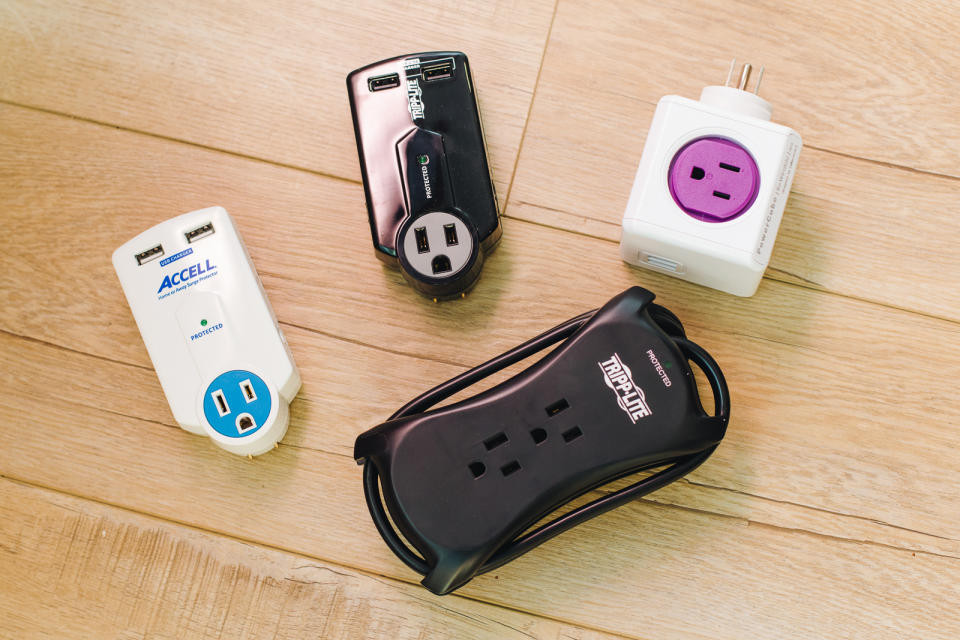
We didn't find many useful professional reviews of travel power strips, so we started from scratch with our own criteria.
Size and weight: When traveling, the most important factors to consider for whatever you'll be packing are size and weight. A power strip isn't going to do you any good if it's too bulky or heavy to stick in a carry-on or checked baggage, or if it can't be squeezed into an outlet located behind a desk or nightstand in a hotel room. So to keep our picks to a travel-friendly size, we limited most of our contenders to power strips with no more than three AC outlets and two USB ports—our international pick is the sole exception.
Outlet placement: We tried to find models that position AC outlets in a way that maximizes the number of devices you can plug in, regardless of the size or shape of those devices' power cables or power bricks—we dismissed models with AC outlets that are too close together.
Plug design: If the power strip's own AC outlet plug retracts or folds into the body of the device when not in use, it not only makes it easier to fit it into smaller packing spaces, but also helps prevent the plug from snagging on other items in the bag—damaging itself or those items. It's also important that plugging the power strip into an outlet doesn't block the other outlet in the same receptacle.
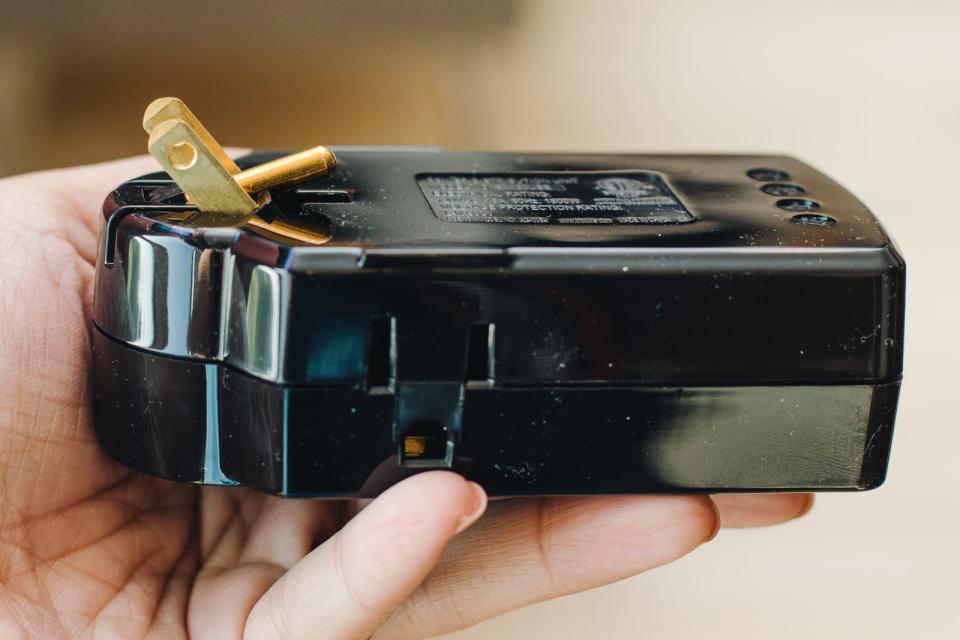
Surge protection: Ideally, any power strip is also a good surge protector, but in practice, most portable versions are too small to include meaningful protection. The joule rating on the box will give you some indication of how long a given model will take cumulative hits, but not how much power could hit the gear you have plugged in. For example, a portable unit with a 540-joule rating won't be able to take as much punishment as a home model with with a rating over 3,000. But what matters to the survival of your gear is how much voltage from a surge makes it through the outlets. In other testing, we've found that many electronics can survive a 400-volt hit—the amount most home surge protectors let through when struck by a 5,000-volt surge. Most portable models, though, let through over 1,000 volts of the same surge. We call out models that can serve as true surge protectors, but if that's your main concern, you'll need to invest in a larger option.
USB charging: Finally, given the number of devices and accessories that charge via USB, we limited our search to power strips that also have high-current USB-charging ports. Most recent iPads require 2.4-amp current to charge at full speed, but few of the power strips we found can provide that much current, so we settled for models that can provide 2.1 amps. Unfortunately, most of the units we tested split this current over two ports, rather than providing up to 2.1 amps per port. This means that if you plug in two iPads, for example, they'll each charge at less than half their maximum speed, because each will be getting only roughly 1 amp of charging current.
Using these criteria, we cut our list of candidates from dozens to just a few. We then combed through warranty policies and read customer reviews on Amazon. We started covering this topic in 2013, and in all that time, we've found only a handful of models worth testing: the Mediabridge Portable Surge Protector (now discontinued), Belkin Mini Surge Protector, Monoprice 3 Outlet Power Surge Protector (now discontinued), 360 Electrical Power Curve Mobile Surge Protector, CyberPower CSP300WU, Accell Home or Away Surge Protector, Tripp Lite Protect It 3-Outlet Surge Protector, Tripp Lite Protect It 3-Outlet Travel-Size Surge Protector, PowerCube ReWireable USB, and several other models from PowerCube.
How we tested
For all models we tested, we tried plugging a variety of chargers with different plug shapes—for devices like laptops, tablets, digital-camera batteries, and smartphones—into the power strips. We tried different combinations to see which power strips could accommodate the greatest number and variety of devices. We also took into account the design of the power strip and the placement of its plug, and considered if it could be used without blocking the adjoining wall outlet in a two-outlet wall plate.
Next, we looked at the USB charging ports and tested the charging capabilities of each. We did this by plugging in a PortaPow USB Power Monitor (similar to this model) along with an iPad Air 2, noting the monitor's amperage reading. We then connected a second iPad to measure the total output while charging two devices.
For our late-2017 update, we didn't find any new models to try, but we expanded testing on our picks from Accell, Tripp Lite, and PowerCube to see how tough their surge protection capabilities really are. Our electrical engineer, Lee Johnson, tested each model with a 5-kilovolt surge generator, capable of creating voltage surges 40 times the standard AC power in the US. He started with a series of surges from 160 volts all the way to 5,000 volts, recording the voltage at the outlet where you would normally plug in your other devices. Then he did a series of five 5,000-volt surges, and averaged the outlet measurements to get the protected output voltage. As a control, he also tested an LCD computer monitor's resilience in the face of a surge. First, he sent a 400-volt surge through the monitor, about the same amount of power that would get through a home surge protector. The monitor powered on and displayed images without a problem. Then he surged it directly with 5,000 volts from our generator, and with a loud pop, the monitor was dead. In the future, we'd like to test more electronics at more voltages to determine when they'll fry, but for now, we're comfortable knowing that 400 volts is indeed safe in the short term for similar gear.
Our pick: Accell Home or Away Surge Protector/Tripp Lite Protect It 3-Outlet Surge Protector
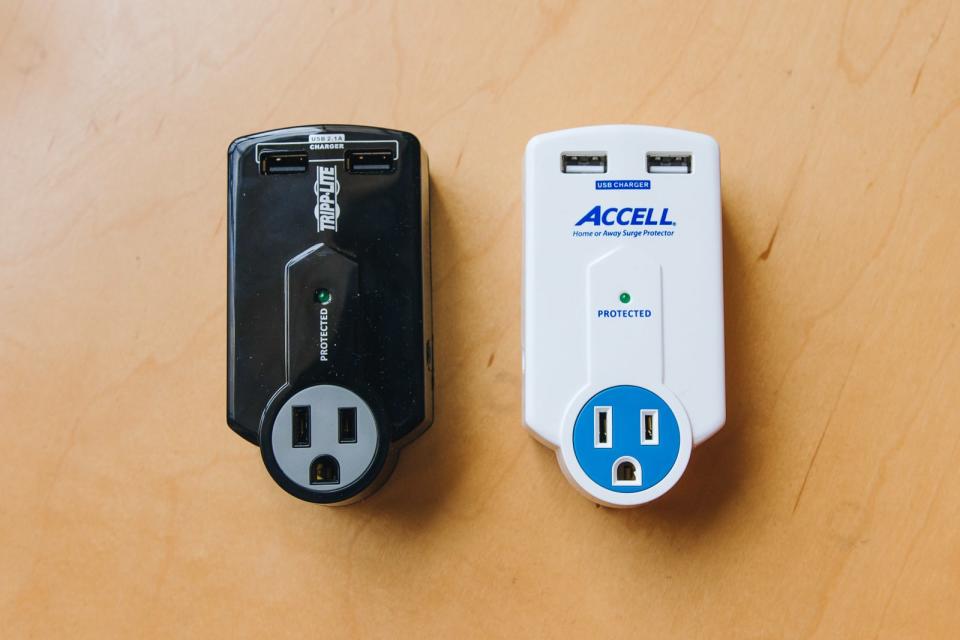
Accell's Home or Away mobile power strip (model name D080B-010K for the white version, D080B-011K for the black) edged out its competition in every category: size, design, and USB-charging capability. It's small, its USB ports charge connected devices as fast as any of the competition, and it's inexpensive. The Tripp Lite Protect It 3-Outlet Surge Protector is the same design with the same capabilities, so just buy whichever one is cheaper the day you order.
The Accell/Tripp Lite design is the only one we saw that keeps all three AC outlets easily accessible at all times, because they're placed on different faces. Because of this, it can accommodate an impressive variety of devices and plug sizes—we tried every size and shape of device charger and plug we could find, and it handled them all easily (even simultaneously). There might be some combination of plugs that doesn't work, but we haven't found it yet. In fact, we even managed to get three of the other, larger power strips to plug into the Accell/Tripp Lite. Other power strips couldn't handle two large plugs next to each other, but it wasn't a problem for the this model. And though it's easier to plug very large plugs into the front outlet, larger plugs can still squeeze into the side outlets.
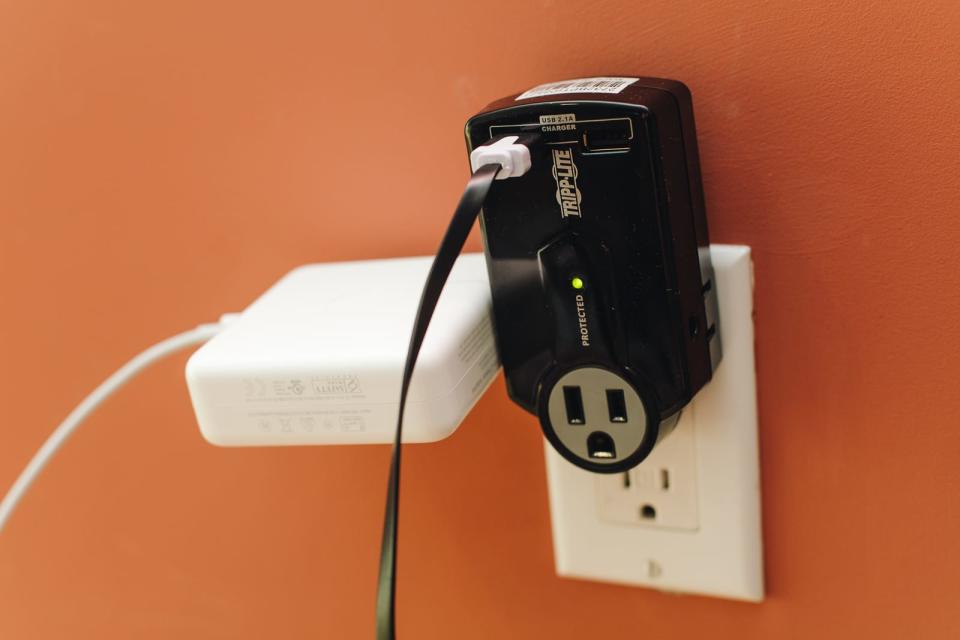
At 4½ inches long, 2½ inches wide, and just under 1½ inches deep, the Home or Away and Tripp Lite 3-Outlet are the smallest of any of the power strips we tested. Each easily fits into smaller backpack or carry-on-luggage pockets, and their plug prongs fold away neatly when not in use. You'll also barely notice the 5-ounce weight in your bag.
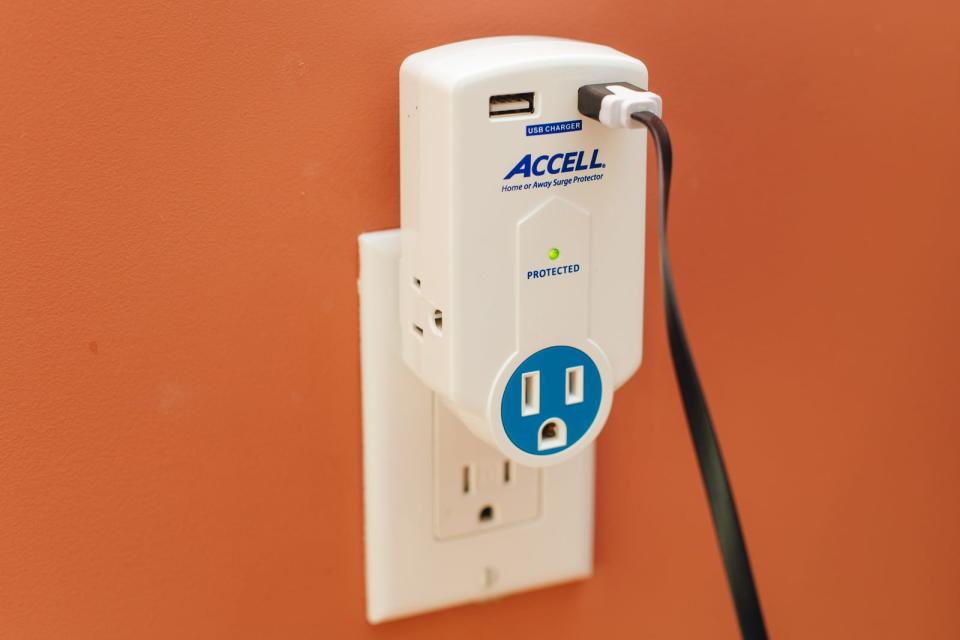
Despite the small size, the Accell Home or Away and Tripp Lite 3-Outlet are very sturdy. Each stayed solidly in the wall outlet and didn't wobble around, even when it had three very large plugs and adapters plugged into it. This was a problem with some of the other models—the Belkin, for example, did not sit flush against the wall when plugged in; it left a gap between the wall and the body of the power strip, regardless of if anything was plugged into it.
That said, the best-designed model would still be useless if it didn't work well. Fortunately, in our testing, the Home or Away and Tripp Lite 3-Outlet outperformed the competition. Each functioned exactly as advertised in our USB speed tests: With a single iPad Air 2 connected to one of the unit's USB power ports, we saw 2.1 amps of power draw; plugging a first-generation iPad Air into the second USB port halved that figure to each, as expected. This means that with two iPads or other high-draw devices plugged into the unit's USB power ports, each device's charging speed will be less than half of what you'll get with that device's own charger, or our favorite multiport USB chargers. This is not optimal performance, but it is par for the course for this type of product, and we couldn't find anything with independent 2.1-amp or 2.4-amp USB ports.
Flaws but not dealbreakers
Because they're rated for only 110-volt outlets, we don't recommend using the Accell Home or Away or Tripp Lite 3-Outlet internationally. Even if plugged into an international adapter, it's not a safe option, because most countries have 220-volt electrical grids. If you need an international power strip, we have a recommendation below.
We also find it disappointing that the USB charging speeds don't match those of modern devices. Sure, you can charge a single high-draw device at close to full speed, but connecting two will charge each at rather slow speeds. Of course, you can always plug a high-speed charger into one of the unit's three AC outlets, but part of the appeal of USB charging ports on your power strip is being able to leave those chargers at home.
The manufacturers might call this a surge protection, but we don't, because, according to our tests, the included protection isn't likely to save your gear. When we sent a 5,000-volt surge through the Accell Home or Away and the Tripp Lite 3-Outlet, each let nearly 1,000 volts continue through the outlets to your devices. That's far above the 350 to 400 volts that home surge protectors let through and that most electronics can handle without dying a loud and smoky death. Because this amount of surge protection is so lacking, we didn't worry about the one minor difference between the Accell version and the Tripp Lite version: The former has a 612-joule rating; the latter is just 540 joules. This difference means that the Accell might survive a little more surge damage than the Tripp Lite, but it's such a small difference, on a feature you can't rely on anyway, that the distinction is moot. Home surge protectors, by comparison, offer 2,000 to 3,500 joules of protection before they wear out. If you're looking for surge protection, we recommend the Tripp Lite Protect It 3-Outlet Travel-Size Surge Protector, below, which clamps voltages better and will last longer.
Also great: Tripp Lite Protect It 3-Outlet Travel-Size Surge Protector
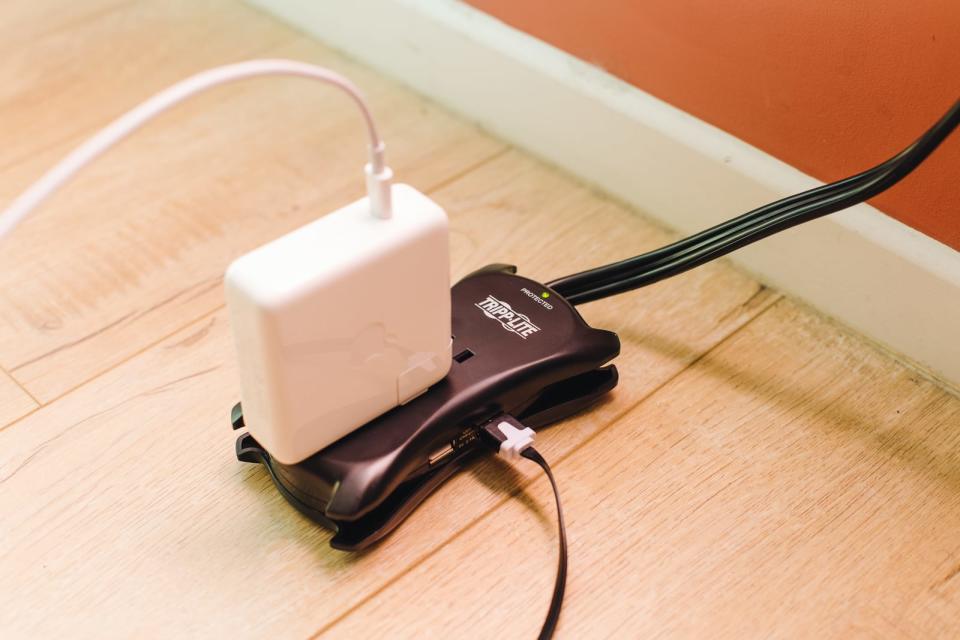
If you want real surge protection on the go, or prefer a power strip with a cord instead of one that sits right on the wall outlet, the Tripp Lite Protect It 3-Outlet Travel-Size Surge Protector is the best choice. It has an outlet layout that's almost as good as the one on the Accell Home or Away and Tripp Lite Protect It 3-Outlet, but adds surge protection that's more than twice as good. But it is slightly bulkier, which may be a dealbreaker for anyone who packs light.
With two outlets on the front face and a third on the back, the Tripp Lite Travel-Size can accommodate at least one large power brick without blocking the other outlets. Models like the Cyber Power Systems CSP300WU or the Belkin Mini Surge Protector put all three outlets in a row, where a single power brick can get in the way of adjacent outlets.
Because the Tripp Lite Travel Size plugs into the wall with an 18-inch cord instead of sitting right at the outlet, it doesn't block the second wall outlet like other units can. And because it has a right-angle wall plug, this strip is a far better solution for outlets behind furniture—a huge plus if you're often plugging into obstructed outlets in hotel rooms or Airbnbs.
Aside from the outlet spacing and the flexibility of a corded model, the other reason to choose the Tripp Lite Travel-Size is its solid performance as a surge protector. When we hit it with repeated 5,000-volt surges, it let only an average of 447 volts through to the outlets. That's close to the performance of our favorite home surge protectors that let between 368 and 444 volts through in the same test. (We've tested 400-volt surges on computer monitors and found that they can handle such a spike, though we didn't test repeated surges over a longer timeframe.) Three other portable models that we tested allowed nearly 1,000 volts to pass from our surge generator to the power strip outlets where devices would be connected. That's enough to endanger most electronics, which makes the protection anything but.
Not only does the Tripp Lite Travel-Size provide better protection for each individual surge, but it should handle more surges before wearing out. The protection circuitry inside is rated to take a cumulative 1,050 joules before wearing out, or about twice that of one of our top picks, the Tripp Lite 3-Outlet. Though joule ratings aren't perfectly linear, that means that the Travel-Size should last much longer as a surge protector.
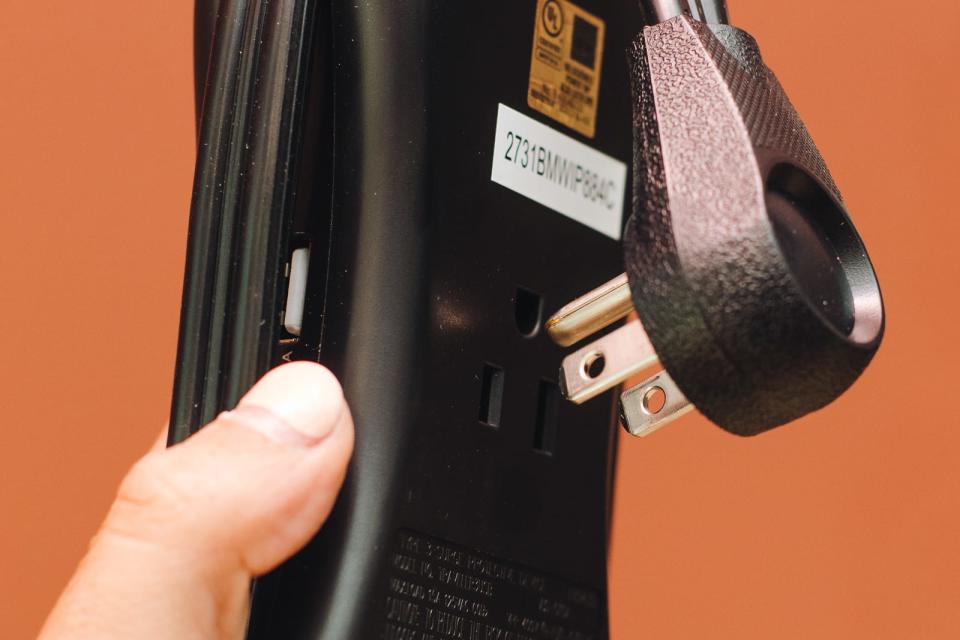
Like our other picks, the Travel-Size also includes two USB ports that charge devices at up to 2.1 amps. But also like every portable power strip we tried, that total is shared between the two ports. Apple and some other manufacturers include 1-amp chargers with their phones, so charging with the Travel-Size will actually be faster, even when charging two phones at a time. But most modern phones and tablets can fast-charge at more than 2 amps, so if you're charging multiple devices at the same time, you'll be better off with a dedicated USB charger.
Also great: PowerCube ReWireable USB
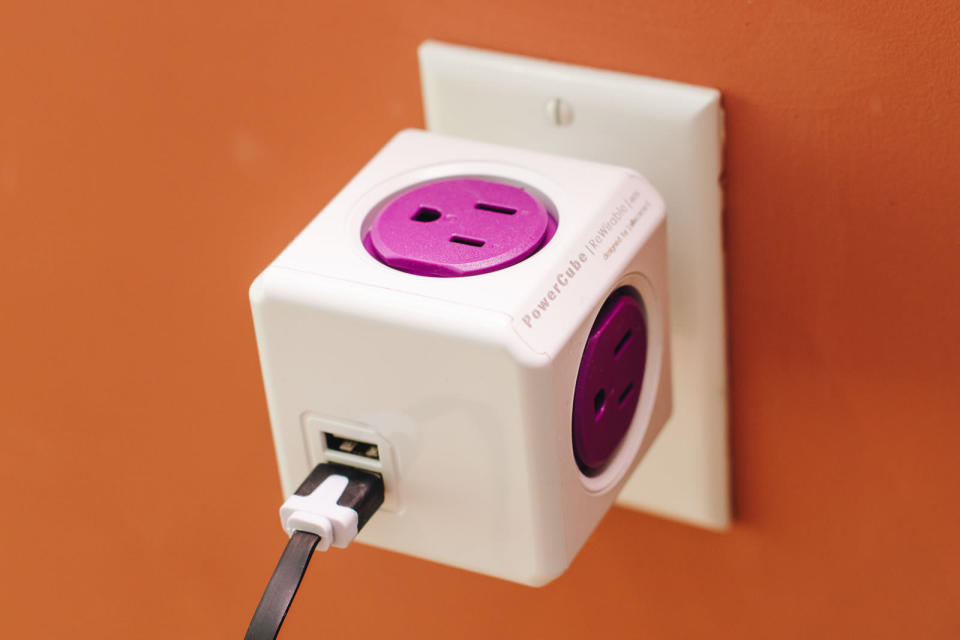
Though the power strips we tested are convenient for traveling, none are recommended for use outside of North America, because none are rated for use with the 220-volt outlets found in most European and Asian countries. In fact, many of the manuals included with these power strips specifically state that their warranties are void should you use the them outside of the US.
One option that will work abroad—and the only model we found that met our criteria—is PowerCube's ReWirable USB. The PowerCube unit works with 100 to 250 volts, so it can be safely plugged in pretty much anywhere in the world.
The PowerCube ReWirable USB is a 2½-inch cube and weighs barely more than 7 ounces. It has one outlet on each of its four outside faces, plus two USB ports on the face opposite its own AC plug. This design ensures full access to each outlet by almost any size plug without any of those plugs blocking the other outlets. The USB ports share 2.1 amps, much like on our other picks.
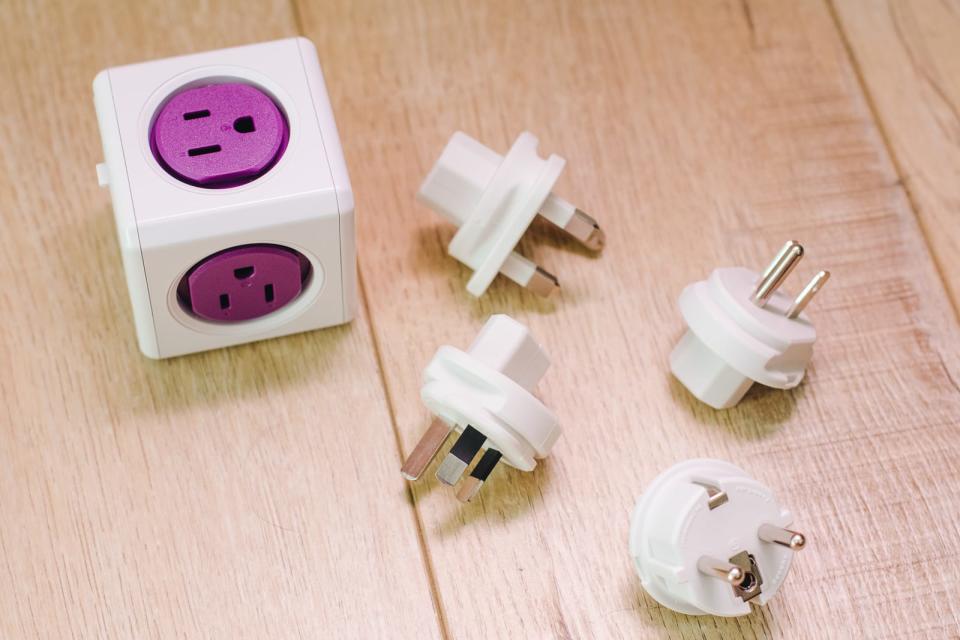
Included with the PowerCube unit are four interchangeable AC plugs to fit Australian, European, North American, and UK outlets. The plugs are easy to swap in and out as needed, and because they push the cube a fraction of an inch away from the wall, the wall plate's second outlet will be accessible for most plugs and power bricks in most situations. However, the extra plugs are easy to misplace.
Though it's not advertised with any surge protection, we found the PowerCube knocked 5,000-volt surges down to the same 900- to 1,000-volt range as the Accell Home or Away and Tripp Lite 3-Outlet. That is to say, the surge protection is minimal and we wouldn't rely on it.
Long-term test notes
If you need a portable power strip while traveling, we still think our top picks are the best options. But as more gadgets have the ability to draw power over USB or USB-C, we think fewer people need the extra AC outlets that this type of power strip offers. Over the past three years, three Wirecutter editors have taken our top picks—either the Accell Home or Away or the Tripp Lite Protect It 3-Outlet—on dozens of trips. After extensive use, the foldable plug on one of the power strips got stuck in the out position, but they have all been trouble-free otherwise.
Even though one editor continues to pack one of these power strips on every trip, the other two reported that the extra AC outlets have become less important, and that they now tend to pack other chargers instead. Deputy editor and avid traveler Michael Zhao said, "Now you can get a 65W USB-C charger that can charge a phone, laptop, battery pack, tablet, and wireless headphones at a fast speed with just one outlet. That's more practical for me to carry than this." Although the USB chargers he mentioned lack surge protection, portable power strips like our picks offer only token protection anyway. If you tend to pack just one device that needs an AC plug, you may want to consider a multiport USB wall charger or a high-speed USB-C laptop charger instead of a portable power strip.
The competition
Belkin's Travel RockStar Surge Protector is a cool concept on paper. It combines the benefits of a travel surge protector with those of a portable USB battery pack. Unfortunately, it's about twice as heavy and it takes up more space than the Accell power strip, yet it has one less outlet and only a single, 2-amp USB port. A 3,000 mAh battery sets the Travel RockStar apart from the pack, as it's the only such combo we've seen. However, the combination of the Accell or Tripp Lite unit and a great portable USB battery costs a lot less than the Belkin, and although the two pieces will take up a bit more space in your bag, it's easier to walk around with just a battery than with the large Travel RockStar. We hope Belkin iterates on this concept, but it's simply not great yet.
Out of all of the models we looked at, Belkin's Mini Surge Protector was the most popular on Amazon and around the Web, which is why we didn't eliminate it at the start for a tight outlet placement that makes it impractical to use with large power bricks. But in person, that was a real problem. Plus, it weighs almost twice as much as the 5-ounce Accell and Tripp Lite units, and it's considerably longer and wider than the rest of the competition. The swiveling plug lets you rotate it out of the way of a wall plate's second outlet, but the button to swivel and the plug itself tend to get stuck.
360 Electrical's Power Curve Mobile Surge Protector has an innovative design, with two AC outlets next to each other that each rotates a full 360 degrees to maximize the amount of space for devices with larger plugs. This design works surprisingly well: With a little maneuvering, we were easily able to plug in two large, transformer-size adapters without obscuring the adjacent USB ports. The unit is also conveniently sized at just 5 inches long and 2 inches wide—only slightly larger than the Accell and Tripp Lite power strips—and the plug folds away nicely for easy storage. But it has only two outlets instead of three, and the USB ports charge devices slightly slower than the ports on our top picks. Lastly, the two LED indicators are so bright that they could double as a nightlight in an otherwise dark room, which is less than ideal when sleeping in hotels.
The RND Power Solutions Wall Power Station is too bulky, and the outlets are too close together.
This guide may have been updated by Wirecutter. To see the current recommendation, please go here.
When readers choose to buy Wirecutter's independently chosen editorial picks, Wirecutter and Engadget may earn affiliate commissions.
